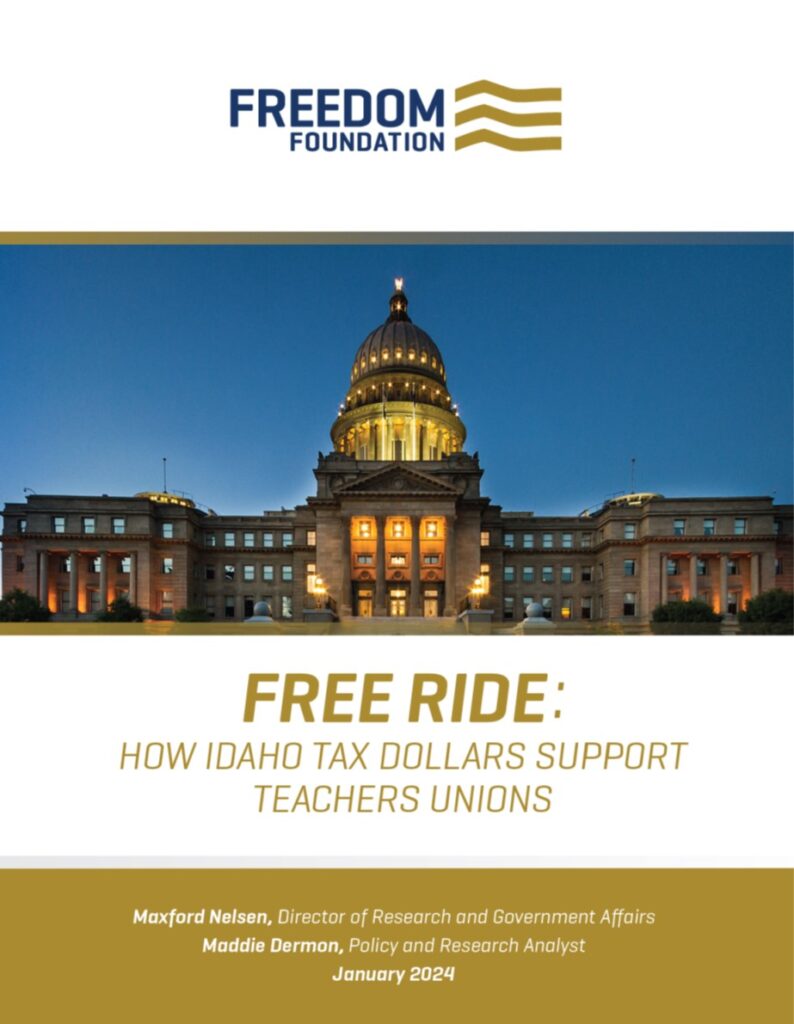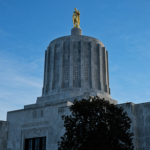INTRODUCTION
Idaho law currently requires school districts to engage in collective bargaining with a teachers union if a majority of district educators select union representation. Of the 117 traditional public-school districts in Idaho, approximately 83 currently negotiate with a teachers union.
The scope of such negotiations is quite broad. State law requires school districts and teachers unions to “negotiate in good faith on those matters specified in any such negotiation agreement” — essentially, the parties can bargain over anything they like. While union negotiations typically involve matters like compensation, conditions of employment, and grievance resolution, teachers unions have taken advantage of the lack of guardrails to use the bargaining process to secure taxpayer support for teachers union activities and even political advocacy.
Local teachers unions in Idaho are generally affiliated with the Idaho Education Association (IEA), itself an affiliate of the National Education Association (NEA), the largest teachers union in the country. Consequently, much of the dues paid by Idaho educators go to support the operations and political advocacy of the IEA and the NEA, rather than towards local unions’ representational services.
As an organization, the NEA is as controversial as it is large. The NEA headquarters in Washington, D.C., alone reported total revenue of more than $600 million in fiscal year 2022, not counting the revenue retained by its hundreds, if not thousands, of state and local affiliates like the IEA. The NEA undoubtedly exerts more influence over the policies and operations of American public schools than any other private special interest group.
From supporting unrestricted increases to the U.S. debt ceiling, to opposing policies seeking to preserve and protect women’s sports, picking sides in the Israeli-Hamas conflict, backing abortion without limit, and supporting gun confiscation, there is essentially no major policy debate in which the NEA does not seek to exert its considerable influence.
In 2021, the Wall Street Journal’s editorial board declared, “The NEA and AFT have become the ideological and institutional vanguard of progressive politics. They are a powerful wing of the Democratic Party…”
Overt politics aside, even the more mundane employment matters addressed by teachers unions in collective bargaining carry significant policy implications.
As the U.S. Supreme Court explained at length in its landmark 2018 ruling in Janus v. AFSCME:
- “‘[I]t is impossible to argue that the level of… state spending for employee benefits… is not a matter of great public concern.’”
- “Take the example of education… The public importance of subsidized union speech is especially apparent in this field, since educators make up by far the largest category of state and local government employees, and education is typically the largest component of state and local government expenditures. Speech in this area also touches on fundamental questions of education policy.”
- “Even union speech in the handling of grievances may be of substantial public importance and may be directed at the ‘public square.’”
Of course, unions have a valid role to play in giving voice to employees in workplace matters and, as a private organization, the NEA and its affiliates are and should be free to advocate for any causes or political candidates they like, so long as they do it with their own funds derived from voluntary memberships freely purchased by the union’s members.
The problem is that the NEA’s headquarters in Washington, D.C., specifically encourages its affiliates to prioritize certain “essentials to a strong union contract” that involve securing special legal privileges at taxpayers’ expense. In many states, teachers unions have effectively roped taxpayers into subsidizing union activity and advocacy, thereby inflating their influence. Unfortunately, Idaho is no exception.
The Freedom Foundation’s review of current and recent school district collective bargaining agreements with teachers unions available in the Idaho School Boards Association database identified six ways in which teachers unions benefit from government funds, facilities, resources, and personnel:
1. Government collection of union dues
Of the 83 districts with known teachers unions analyzed, at least 52 deduct union dues from educators’ paychecks and forward the funds to a teachers union. Over the course of a year, these districts collect about $4.4 million in dues from over 5,000 teachers, about $1.1 million of which is forwarded to the NEA headquarters in Washington, D.C., and used to advance its political advocacy. The total cost to taxpayers of school districts’ dues collection for teachers unions could run tens of thousands of dollars.
2. School districts paying teachers’ union dues
The Boise School District offers teachers a monthly salary enhancement approximating the cost of teachers union dues, and nothing would prevent a district from explicitly paying teachers’ dues or, for that matter, contributing funds directly to the union.
3. Enhanced access to teachers’ personal information
Teachers unions in at least two districts have successfully bargained for the right to personal contact information about teachers that any other member of the public would be prohibited from acquiring under the state Public Records Act.
4. Union participation, and membership solicitation, during new employee orientations
At least a dozen school districts allow teachers unions to solicit membership as part of the district-operated new hire orientation process, with no apparent ability for teachers to opt-out.
5. Release time for teachers union officials
At least 51 school district teachers union contracts include release time provisions requiring taxpayers to foot some or all of the bill for teachers’ time spent out of the classroom while attending to union business during working hours. The total cost to taxpayers could easily exceed half-a-million dollars per year, equivalent to about half-a-dozen teachers working full-time for the union at taxpayers’ expense.
6. Privileged access to and use of school facilities and resources
At least 31 districts have agreed, in bargaining, to grant the teachers union privileged, no-cost access to and use of school facilities far above and beyond what community organizations or even rival unions are entitled to.
To better balance the interests of educators and taxpayers, Idaho lawmakers can and should prohibit school districts from using taxpayer funds to promote teachers unions in these ways.











